I just can't get past square one on JLayeredPanes. (See my original question of yesterday. I have been studying the JLayeredPane tutorial and API. These tutorials are geared somewhat differently to what I am ultimately trying to produce.
Going back to square one, I took Oracle's JFrame Example and modified it to include Layered panes.
Here is the code:
package components;
import java.awt.*;
import java.awt.event.*;
import javax.swing.*;
/* FrameDemo.java requires no other files. */
public class FrameDemo {
/**
* Create the GUI and show it. For thread safety,
* this method should be invoked from the
* event-dispatching thread.
*/
private static void createAndShowGUI() {
//Create and set up the window.
JFrame frame = new JFrame("FrameDemo");
frame.setDefaultCloseOperation(JFrame.EXIT_ON_CLOSE);
JPanel mainLayer = new JPanel(new BorderLayout());
mainLayer.setPreferredSize(new Dimension(640, 480));
frame.setContentPane(mainLayer);
frame.getLayeredPane().add(mainLayer, JLayeredPane.DEFAULT_LAYER, 0);
JLabel emptyLabel = new JLabel("LABEL");
emptyLabel.setPreferredSize(new Dimension(320, 240));
mainLayer.add(emptyLabel, BorderLayout.NORTH);
JPanel subLayer = new JPanel(new BorderLayout());
JLabel subLabel = new JLabel("SUBLABEL");
subLabel.setPreferredSize(new Dimension( 200, 100));
subLabel.setBackground(Color.YELLOW);
subLayer.add(subLabel, BorderLayout.SOUTH);
subLayer.setVisible(true);
subLabel.setVisible(true);
frame.getLayeredPane().add(subLayer, JLayeredPane.PALETTE_LAYER, 0);
//Display the window.
frame.pack();
frame.setVisible(true);
}
public static void main(String[] args) {
//Schedule a job for the event-dispatching thread:
//creating and showing this application's GUI.
javax.swing.SwingUtilities.invokeLater(new Runnable() {
public void run() {
createAndShowGUI();
}
});
}
}
Why doesn't it work? IOW, why doesn't the sublabel show up? It's at a higher level than the main layer.
One thought is why am I adding mainLayer to both the Content Pane and the Layered Pane? If I don't do that, nothing shows up. I.e, by commenting out this line, I just get a blank frame.
// frame.setContentPane(mainLayer);
Obviously, I'm not understanding something. But what is it?
I should add that obviously, this simple demo can be done without Layered Panes. But my ultimate goal is to have a layer that can be turned on and off programatically. But I can't even get this simple case to work. If I can get over this hump, I think the rest will be easier.
ADDENDUM:
What I want to acheive is illustrated by the following Code, which is very similar to what TrashGod set up below and it works. There is a JLayeredPane with a constant layer (layered at Integer(0)) and a floating layer layered initially at Integer(-1) but togglable by the F7 and F8 keystrokes between the Integer(-1) layer and the Integer(1) layer, thereby allowing it to float above or below the constant layer.
package components;
import java.awt.*;
import java.awt.event.*;
import javax.swing.*;
/* MyLayeredPaneDemo.java requires no other files. */
public class MyLayeredPaneDemo {
private JFrame frame;
private JLayeredPane mainPanel;
private JPanel constantLayer;
private JPanel floatingLayer;
/**
* Create the GUI and show it. For thread safety,
* this method should be invoked from the
* event-dispatching thread.
*/
private MyLayeredPaneDemo() {}
private void createAndShowGUI() {
//Create and set up the window.
this.frame = new JFrame("MyLayeredPaneDemo");
this.frame.setDefaultCloseOperation(JFrame.EXIT_ON_CLOSE);
this.frame.setPreferredSize(new Dimension(640, 480));
mainPanel = new JLayeredPane();
constantLayer = new JPanel(new BorderLayout(0,0));
floatingLayer = new JPanel(new BorderLayout(0,0));
// constantLayer.setPreferredSize();
constantLayer.setOpaque(true);
constantLayer.setBackground(Color.BLUE);
JLabel constantLabel = new JLabel("MAIN LAYER");
constantLayer.setPreferredSize(new Dimension(640, 480));
constantLayer.add(constantLabel, BorderLayout.CENTER);
JLabel subLabel = new JLabel("SUB LAYER");
floatingLayer.setBackground(Color.YELLOW);
floatingLayer.add(subLabel, BorderLayout.SOUTH);
floatingLayer.setOpaque(true);
floatingLayer.setVisible(true);
floatingLayer.setVisible(true);
subLabel.setBackground(Color.YELLOW);
mainPanel.add(constantLayer, new Integer(0), 0);
constantLayer.setBounds(0,0,640,480);
mainPanel.add(floatingLayer, new Integer(-1), 0);
floatingLayer.setBounds(100, 360, 300, 90 );
frame.add(mainPanel, BorderLayout.CENTER);
//Display the window.
mapKeyToAction(frame.getRootPane(),
JComponent.WHEN_ANCESTOR_OF_FOCUSED_COMPONENT,
KeyStroke.getKeyStroke(KeyEvent.VK_F7, 0),
"Hide Layer",
new AbstractAction() {
@Override
public void actionPerformed(ActionEvent e) {
System.out.println("F7 pressed");
mainPanel.setLayer(floatingLayer, new Integer(-1));
}
});
mapKeyToAction(frame.getRootPane(),
JComponent.WHEN_ANCESTOR_OF_FOCUSED_COMPONENT,
KeyStroke.getKeyStroke(KeyEvent.VK_F8, 0),
"Show Layer",
new AbstractAction() {
@Override
public void actionPerformed(ActionEvent e) {
System.out.println("F8 pressed");
mainPanel.setLayer(floatingLayer, new Integer(1));
}
});
frame.pack();
frame.setVisible(true);
frame.getRootPane().setFocusable(true);
boolean ok = frame.getRootPane().requestFocusInWindow();
System.out.println("focus ok: " + ok);
}
public static void main(String[] args) {
//Schedule a job for the event-dispatching thread:
//creating and showing this application's GUI.
javax.swing.SwingUtilities.invokeLater(new Runnable() {
public void run() {
new MyLayeredPaneDemo().createAndShowGUI();
}
});
}
private static void mapKeyToAction(JComponent component,
int whichMap, KeyStroke keystroke,String key, Action action) {
component.getInputMap(whichMap).put(keystroke, key);
component.getActionMap().put(key, action);
}
}
However, I am having trouble getting this to work in my real case. The difference between the two is that here, my JLayeredPane is owned by the Frame, whereas in my real application, I want the JLayeredPane to be owned by a JPanel is that some levels down in the containment hierarchy from the Frame, and whose size is set by a GridBagLoyout in its parent, and the size is therefore unknowable at the time its constructor is called, making it difficult to call setBounds() which I need to do on a child of a JLayeredPane.
FURTHER ADDENDUM. I know that the Oracle Tutorials mention a case where Layouts rather than absolute positioning is used with a JLayeredPane. The difference between this case and mine is that in my case the layers occupy the same horizontal space on different layers, whereas in this case, the components on different layrers occupy different horizontal spaces. It's almost as if we need a 3D Layout Manager!
